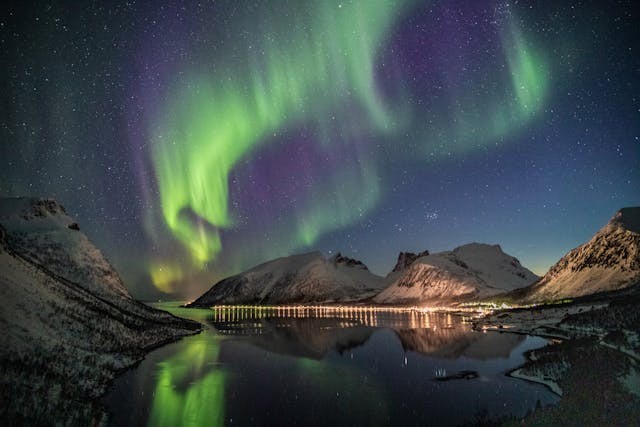The National Oceanic and Atmospheric Administration's (NOAA) Space Weather Prediction Center (SWPC) has issued a geomagnetic storm warning for today, Sept. 16, thanks to a combination of powerful solar events. The storm could spark auroras deep into mid-latitudes, making the northern lights visible as far south as California, Missouri, and Oregon.

Two solar events cause the storm, Space.com reported. The first is a massive coronal mass ejection (CME) released during an X-class solar flare, one of the most powerful types of solar flares, on Sept. 14. This X4.5 flare, which peaked at 11:29 a.m. EDT (1529 GMT), was the fifth largest of the current solar cycle. The CME is currently headed toward Earth, and its arrival is expected today. When the charged particles from the CME collide with Earth's magnetosphere, they trigger geomagnetic storms, which can produce the auroras seen as the northern or southern lights.
The second solar event is a coronal hole on the Earth-facing side of the sun. Coronal holes, visible as dark regions in the sun's corona, allow solar wind streams to escape into space. This fast solar wind and the incoming CME have prompted NOAA to issue a G3 geomagnetic storm warning, indicating strong storm conditions. NOAA's G-scale ranges from G1 (minor) to G5 (extreme), and today's G3 level could provide a spectacular aurora display.
The big #solarstorm launched during the X4.5-flare is on its way to Earth. NOAA & NASA predictions indicate arrival anytime from 0600 UTC to 1800 UTC September 16. Likely the storm will arrive on the late side, possibly deflected further east by a fast solar wind stream. My… pic.twitter.com/ifT4UZt6jU
— Dr. Tamitha Skov (@TamithaSkov) September 16, 2024
Previous G1 storms have produced dazzling northern lights across the U.S. and Canada, so the more powerful G3 storm is expected to be even more striking. However, predicting space weather can be challenging, and there is no guarantee the storm will be as intense as anticipated.
According to space weather physicist Tamitha Skov, the storm is predicted to hit between 0600 UTC and 1800 UTC on Sept. 16, though the exact timing remains uncertain. Space weather forecaster Sara Housseal also provided updates, noting that while the CME's arrival is expected soon, it's possible it may arrive later or fizzle out.
Northern Lights Photographs
People were pleased to get a glimpse of the norhtern lights and have shared photos on social media.
Tonight’s stunning #aurora display from the X4.5 #solarflare #CME arrival. The skies of South Indian Lake, Manitoba lit up with beautiful colors!
— Rj Roldan (@rjayroldan) September 17, 2024
Short but sweet colorful show.#tweetaurora #northernlights #auroraborealis #astronomy @TamithaSkov @AuroraJAnderson pic.twitter.com/UMiC9dk6nH
Just a couple of shots of the #Aurora and the nearly #fullmoon . @mikesobel @CiaraYaschuk @StellaCFCW @TamithaSkov @HouckisPokisewx @PeakToSailPhoto @chunder10 @TweetAurora @goeastofYEG @dartanner pic.twitter.com/TrewYMuYUU
— Images By Stan (@ImagesByStan) September 17, 2024
Aurora substorm near Gilman, MN. #mnwx #aurora #AuroraBorealis #Northernlights @TamithaSkov @spacewxwatch @Wicky_dubs_WX @wxkylegillett pic.twitter.com/ra65rWqKyq
— Ewan Newbold (@ENewboldWx) September 17, 2024










